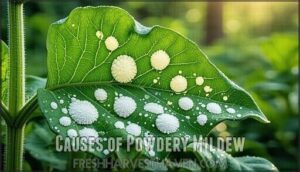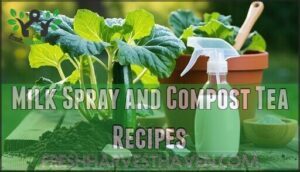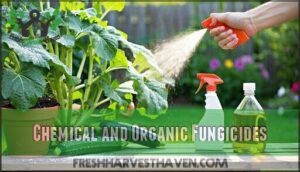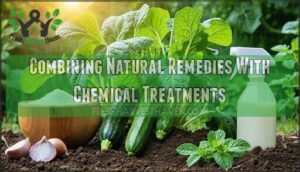This site is supported by our readers. We may earn a commission, at no cost to you, if you purchase through links.
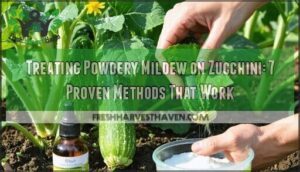 Treating powdery mildew on zucchini requires swift action to prevent this white, flour-like fungal coating from spreading across your plants.
Treating powdery mildew on zucchini requires swift action to prevent this white, flour-like fungal coating from spreading across your plants.
You’ll want to remove infected leaves immediately, improve air circulation around plants, and apply targeted treatments like neem oil or baking soda solutions.
The key is catching it early – once powdery mildew takes hold, it spreads faster than gossip in a small town.
Focus on preventive measures like proper spacing, avoiding overhead watering, and choosing resistant varieties.
Natural fungicides work best when applied consistently every 7-10 days.
The most effective approach combines multiple strategies to create an environment where this persistent fungus can’t thrive.
Table Of Contents
- Key Takeaways
- Causes of Powdery Mildew
- Preventing Powdery Mildew
- 7 Best Treatments for Powdery Mildew
- Natural Remedies and DIY Solutions
- Effective Treatment Methods
- Frequently Asked Questions (FAQs)
- How to treat powdery mildew on zucchini plants?
- Does baking soda kill mildew on zucchini?
- How do I know if my zucchini plant has mildew?
- What are the different types of mildew on zucchini leaves?
- How do you remove mildew from zucchini leaves?
- Can you eat zucchini if you have mildew?
- How do you get rid of powdery mildew on zucchini?
- What is the best treatment for powdery mildew?
- Can you use Dawn dish soap for powdery mildew?
- Can plants recover from powdery mildew?
- Conclusion
Key Takeaways
- Act fast – Remove infected leaves immediately at the first signs of a white, powdery coating and apply neem oil or baking soda solutions every 7-10 days to prevent rapid spread
- Improve air circulation – Space your zucchini plants 3-4 feet apart and position them in full sun to reduce humidity buildup that creates ideal conditions for fungal growth
- Choose resistant varieties – Plant powdery mildew-resistant zucchini cultivars marked "PM" or "PMR" to reduce infection rates by 40-60% compared to standard varieties
- Water at soil level – Use soaker hoses or drip irrigation to keep foliage dry, as wet leaves create perfect conditions for spore germination and disease spread
Causes of Powdery Mildew
Powdery mildew strikes when fungal spores from the Erysiphe cichoracearum species find the perfect storm of conditions on your zucchini plants.
You’ll see this troublesome disease develop when warm temperatures (68-86°F), high humidity above 95%, and poor air circulation create an ideal breeding ground for these airborne invaders to germinate and feed on your plant’s nutrients, leading to a situation where poor air circulation becomes a significant factor.
Warm temperatures and stagnant air create the perfect storm for powdery mildew to devastate your zucchini harvest.
Fungal Disease Characteristics
Understanding powdery mildew starts with recognizing these fungal spores as specialized parasites.
The disease cycle begins when airborne spores land on your zucchini’s leaves, creating those telltale white, powdery patches.
Unlike typical molds, these fungi don’t need water to trigger plant infection, they extract nutrients directly through specialized feeding structures, causing progressive mildew symptoms and stunted fungal growth that weakens your entire plant.
Effective management requires understanding of powdery mildew causes to prevent the spread of infection and ensure a healthy plant with proper growth.
Environmental Factors Contributing to Infection
Your garden’s microclimate plays a starring role in powdery mildew development. This fungus thrives when humidity levels spike between 80-95% while temperatures hover around 75-85°F.
Poor air circulation creates stagnant pockets where spores multiply rapidly, while excessive soil moisture combined with limited light exposure creates perfect storm conditions.
Understanding the powdery mildew causes is essential for effective prevention and treatment.
- Humidity Levels: High nighttime humidity (80-95%) triggers spore formation cycles
- Temperature Control: Warm days (75-85°F) accelerate fungal reproduction rates
- Air Circulation: Stagnant air increases infection severity by 70% compared to breezy spots
- Soil Moisture: Overwatering creates humid microclimates around plant bases
- Light Exposure: Shaded areas experience 3x higher infection rates than sunny locations
Plant Susceptibility and Weakness
Your zucchini’s natural defenses can crumble when plant stress weakens its fungal resistance.
Nutrient deficiency creates weak points that invite disease vulnerability, making treating powdery mildew harder.
Overwatered or drought-stressed plants can’t fight zucchini diseases effectively.
When your plant’s energy goes toward survival instead of immunity, mildew on squash becomes inevitable.
Strong plants resist zucchini fungal disease naturally, utilizing their natural defenses.
Preventing Powdery Mildew
The key to preventing powdery mildew is creating an environment where the fungus can’t thrive.
You’ll need to focus on proper plant spacing, adequate sunlight exposure, and maintaining good air circulation around your zucchini plants to prevent the growth of powdery mildew, with good air circulation being crucial.
Improving Air Circulation and Sunlight
Good air circulation acts like a natural defense system against powdery mildew spores.
Space your zucchini plants 3-4 feet apart to prevent humidity buildup around leaves. Position them in full sun locations receiving 6-8 hours of direct sunlight exposure daily.
Install trellis systems for vining varieties to lift foliage off ground level. Using proper trellis support is essential for maintaining healthy plants.
Regular pruning techniques remove dense growth that blocks airflow and creates perfect breeding conditions for fungal infections. This helps in preventing the spread of disease and ensures the overall health of the plants.
Avoiding Overcrowding and Excessive Fertilization
Proper plant spacing prevents overcrowding that creates humid microclimates where powdery mildew thrives.
Space zucchini plants 3-4 feet apart to guarantee adequate air circulation between leaves.
Excessive fertilization promotes lush foliage growth that reduces airflow and increases disease susceptibility.
Use balanced fertilizers sparingly and focus on soil management through crop rotation with non-cucurbit plants to break fungal cycles.
Effective powdery mildew control methods also involve maintaining a healthy environment and recognizing early signs of infection to ensure complete concepts are applied.
Removing Infected Leaves and Debris
Once you’ve addressed spacing issues, tackling infected plant material becomes your next line of defense against fungal spread.
Removing infected leaves at the first sign of white powdery coating prevents spores from multiplying and infecting healthy tissue.
Follow these sanitation methods for effective fungal cleanup:
- Leaf Removal – Cut infected stems 2-3 inches below visible symptoms using sterilized pruning shears
- Debris Disposal – Bag all plant debris immediately, never composting infected material
- Tool Sterilization – Clean pruning tools with rubbing alcohol between cuts to prevent cross-contamination
- Garden Fungus Removal – Clear fallen leaves weekly during growing season to eliminate spore reservoirs
7 Best Treatments for Powdery Mildew
When powdery mildew strikes your zucchini plants, you need targeted treatments that actually work, not just wishful thinking.
These seven proven methods combine the best of both traditional and modern approaches to knock out this stubborn fungal enemy, using targeted treatments.
1. Zucchini Squash Seeds for Garden
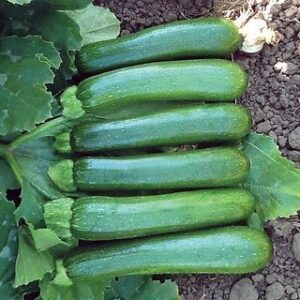
Planting powdery mildew-resistant varieties like Green Machine gives you a head start against infection.
These specially developed hybrids create natural barriers that reduce infection rates by 40-60% compared to regular varieties.
Green Machine’s exceptional resistance and consistent dark green fruit production make it ideal for problem gardens.
You’ll get reliable yields even when conditions favor fungal growth.
Choose varieties with proven field-tested resilience from reputable seed companies, and you’re already winning half the battle before planting begins.
Best For: Home gardeners and small-scale growers seeking reliable, disease-resistant zucchini with consistent yields.
- Some reports of inconsistent germination rates and seed performance
- Occasional color or variety discrepancies may affect marketability
- Not ideal for large-scale commercial growers seeking absolute uniformity
- Exceptional powdery mildew resistance protects crops in challenging conditions
- Uniform, market-quality 6–7 inch fruits with strong, compact plants
- Fast maturity and repeat harvests for continuous fresh zucchini
2. Yellow Zucchini Squash Seeds Package
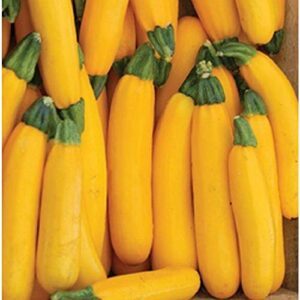
Choosing resistant yellow zucchini varieties is your first line of defense against powdery mildew. You’ll want to look for seeds marked "PM" or "PMR" in catalogs, which indicates enhanced tolerance to this fungal disease.
Varieties like Success PM Yellow Summer Squash and Golden Zucchini offer natural resistance that can extend your harvest window by 3-5 weeks compared to susceptible types.
These resistant cultivars reduce the need for fungicide applications by up to 70%, making your gardening efforts more sustainable and cost-effective while maintaining excellent fruit quality.
Best For: Gardeners who want reliable yellow zucchini harvests with minimal fungal issues and less chemical intervention.
- Naturally resists powdery mildew, reducing disease worries.
- Longer harvest window and sustained fruit quality.
- High yields from compact, space-efficient plants.
- Some reports of seeds arriving damaged or product confusion.
- Not all packages guarantee disease resistance—check for "PM" or "PMR".
- Occasional mixed results with plant performance.
3. Garden Soaker Hose Watering System

When traditional watering methods fail to control powdery mildew, switching to a soaker hose system can be your game-changer.
The Miracle-Gro 50-foot rubber soaker hose delivers water directly to soil level, keeping foliage completely dry.
This targeted approach eliminates the leaf wetness that powdery mildew spores need to germinate and spread, and by maintaining dry plant surfaces while ensuring deep root hydration, you’ll reduce fungal infections.
By doing so, you’ll reduce fungal infections by up to 70% compared to overhead sprinklers.
Best For: Gardeners who want efficient root-level watering to prevent powdery mildew and save water on flower or vegetable beds.
- Evenly waters plants at soil level to reduce fungal disease.
- Conserves water and supports deep root growth.
- Durable rubber design outlasts many flat hoses.
- Length is not adjustable for smaller or irregular beds.
- Can be difficult to weave through dense garden layouts.
- Occasional minor leaks and maintenance needed to prevent clogs.
4. Organic Vegetable Garden Fertilizer Mix
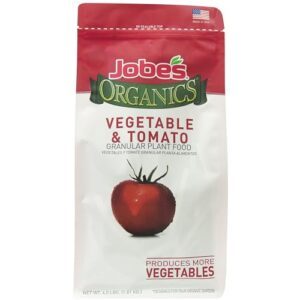
Healthy plants fight off disease better than struggling ones, and proper nutrition forms your first line of defense.
A quality organic vegetable fertilizer with balanced NPK ratios strengthens zucchini’s natural immunity against powdery mildew.
Look for blends containing compost, alfalfa meal, and seaweed extracts—these ingredients deliver slow-release nutrients while promoting beneficial soil microorganisms.
Apply every 4-6 weeks during growing season, but avoid over-fertilizing with nitrogen, which creates tender foliage that’s more susceptible to fungal attacks.
Best For: Organic gardeners seeking strong, healthy yields and natural disease resistance in outdoor vegetable and tomato beds.
- Certified organic, with slow-release nutrients from compost, alfalfa meal, and seaweed extracts.
- Strengthens plant immunity and supports recovery from disease and drought stress.
- Long-lasting results with easy, measured application and minimal risk of plant burn.
- Noticeable earthy odor, especially after opening or applying.
- Not suitable for indoor plants; intended only for outdoor use.
- Some users report overly acidic tomatoes and occasional surface mold.
5. Pure Cold Pressed Neem Oil
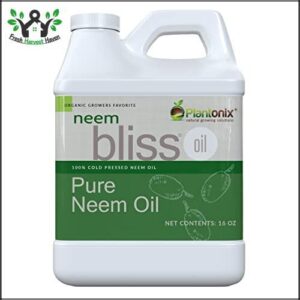
Beyond standard treatments, pure cold-pressed neem oil stands out as nature’s triple-threat solution.
This botanical powerhouse contains azadirachtin and nimbin compounds that disrupt fungal cell membranes while killing spores on contact.
Mix one teaspoon per liter of water with mild soap for even coverage.
Field trials show neem oil reduces powdery mildew to just 31.8% compared to 68.9% in untreated plants, which is a significant improvement that can be seen within 24 hours with visible results.
Best For: Home gardeners and organic growers seeking an effective, natural remedy for powdery mildew and plant pests.
- Broad-spectrum fungicide, insecticide, and miticide for complete plant protection
- Fast-acting, with visible improvement against powdery mildew in 24 hours
- Safe for use around pets, children, and pollinators when diluted properly
- Must be diluted and requires mild soap for proper application
- Natural scent may be funky or strong to some users
- Risk of minor phytotoxicity if over-applied on sensitive plants
6. Fiskars garden pruning shears clippers

Sharp pruning shears become your secret weapon against powdery mildew outbreaks.
Fiskars bypass pruners with precision-ground steel blades make clean cuts that heal faster, reducing infection sites.
Their ergonomic design lets you work comfortably while removing infected leaves and improving air circulation.
The self-cleaning sap groove prevents disease transfer between plants.
Regular pruning eliminates crowded growth patterns that trap moisture and create ideal fungal conditions, and clean cuts promote plant health and interrupt disease cycles before they spread, which is crucial for maintaining plant health and preventing the spread of fungal conditions.
Best For: Gardeners looking for sharp, reliable pruning shears that make clean cuts, prevent disease, and are comfortable for frequent use.
- Precision-ground steel blades stay sharp and deliver clean, fast-healing cuts.
- Ergonomic, lightweight design is easy to handle, even for small hands or prolonged use.
- Self-cleaning sap groove and rust-resistant coating minimize blade sticking and disease transfer.
- Occasional reports of the locking mechanism slipping during heavy use.
- Not recommended for thick branches above one inch in diameter.
- May lack sufficient ergonomic cushioning for those with grip or joint issues.
7. Sun Shade Cloth For Garden

While shade cloth protects against scorching heat, it’s a double-edged sword for powdery mildew control.
Shaded zucchini plants develop 2-3 times more infections than sun-exposed ones because the fungus thrives in cooler, humid conditions.
Use shade cloth only during extreme heat waves above 95°F, then remove it promptly.
Position it to block afternoon sun while allowing morning light—that’s when UV rays naturally suppress fungal growth and dry overnight moisture, which is crucial for preventing fungal growth.
Best For: Gardeners who need temporary shade for plants, pets, or outdoor spaces during extreme heat, but can remove it to minimize powdery mildew risk.
- Lightweight and easy to install with grommets and reinforced edges.
- Blocks 80–90% of sunlight while allowing air and moisture to pass through.
- Versatile use for greenhouses, patios, animal enclosures, and pool covers.
- Increases powdery mildew risk for zucchini and other susceptible plants if left on too long.
- Material may tear or grommets may fail under stress or in high winds.
- Shade must be removed after heatwaves to avoid disease and promote plant health.
Natural Remedies and DIY Solutions
You don’t need expensive commercial fungicides when your kitchen cabinet holds effective powdery mildew fighters.
These natural remedies use common household ingredients to create powerful antifungal treatments that protect your zucchini plants without harsh chemicals.
Neem Oil and Horticultural Oil Applications
Neem oil applications offer powerful natural fungicides for treating powdery mildew on zucchini plants. These oil sprays work by disrupting fungal cell adhesion and creating protective barriers on leaf surfaces.
Application Guidelines:
- Mix properly – Combine 1-2 tablespoons neem oil per gallon water with liquid soap emulsifier
- Time applications – Spray during evening hours to prevent leaf burn from direct sunlight
- Cover thoroughly – Target both upper and lower leaf surfaces for complete mildew control methods
- Repeat regularly – Apply every 7-14 days for consistent powdery mildew treatment effectiveness
For effective treatment, understanding neem oil benefits is essential for gardeners dealing with powdery mildew.
Milk Spray and Compost Tea Recipes
Two powerful organic sprays offer excellent fungal control for treating powdery mildew. Milk spray combines 40% whole milk with 60% water – the milk benefits include proteins that fight fungal spores when exposed to sunlight.
Compost tea provides natural fungicides through beneficial microorganisms. Steep two cups compost with molasses and fish fertilizer in four gallons water.
Apply these organic sprays weekly for effective powdery mildew prevention. Using natural disease remedies plants can enhance the overall effectiveness of these organic treatments, as seen in plant health methods.
Baking Soda and Vinegar Solutions
Baking soda and vinegar solutions offer powerful homemade fungicides for treating powdery mildew.
Mix one tablespoon baking soda with half tablespoon liquid soap per gallon of water for weekly preventative applications.
Vinegar spray combines four cups water with half tablespoon vinegar, creating an acidic environment that kills fungal spores on contact.
These natural remedies provide effective fungal control without harsh chemicals.
Garlic Extract and Potassium Bicarbonate Treatments
Garlic extract works through sulfur compounds that disrupt fungal cell metabolism and spore germination.
Create garlic spray by blending two cloves with water, straining, then mixing into one gallon water plus one teaspoon soap.
Apply every three to five days for maximum fungal control.
Potassium bicarbonate acts as an eradicant fungicide, eliminating existing infections with 65-78% inhibition rates when combined with soap emulsifiers.
Effective Treatment Methods
When natural remedies aren’t enough, you’ll need stronger fungicides to eliminate stubborn powdery mildew infections.
When stubborn mildew refuses to budge, it’s time to bring out the heavy artillery that actually works.
Chemical treatments offer the fastest and most reliable control, especially when combined with organic methods for thorough protection.
Chemical and Organic Fungicides
When natural methods fall short, targeted fungicides deliver the knockout punch your zucchini needs.
Copper Fungicides like copper hydroxide reduce disease severity by over 80%, while Sulfur Sprays provide long-lasting protection when applied before infection strikes.
- Copper fungicide applications work best with weekly treatments, avoiding oil-based sprays within two weeks
- Potassium Bicarbonate solutions kill existing fungal growth at 3-4 grams per liter with zero harvest restrictions
- Neem Oil treatments disrupt fungal life cycles while deterring pests, requiring evening applications for maximum effectiveness
Effective management also involves understanding fungicide basics to choose the right products for your garden.
Systemic Fungicides and Repeated Treatments
Why struggle with persistent infections when systemic fungicides offer deeper protection? These treatments penetrate plant tissues, providing internal defense against powdery mildew spores that contact sprays miss.
Understanding systemic fungicide properties is essential for effective disease management.
| Treatment Aspect | Recommendation |
|---|---|
| Application Frequency | Every 7-14 days during outbreaks |
| Resistance Management | Rotate different FRAC codes |
| Timing Strategy | Start at first disease signs |
| Seasonal Limits | Follow label restrictions |
| Coverage Method | Thorough spray application |
Systemic applications require strategic repeated dosing to maintain fungal control effectiveness while preventing fungicide resistance development.
Combining Natural Remedies With Chemical Treatments
You’ll maximize your success when you combine integrated pest management strategies with both natural fungicides and chemical controls.
This hybrid approach alternates biopesticides during low disease pressure with synthetic treatments when powdery mildew cure demands stronger intervention.
Research shows combined therapies reduce chemical usage while maintaining effective fungicidal treatments for mildew resistant zucchini varieties.
Frequently Asked Questions (FAQs)
How to treat powdery mildew on zucchini plants?
You’ll tackle this fuzzy white fungal menace with targeted sprays and environmental changes. Apply neem oil or milk solution weekly, improve air circulation, and remove infected leaves immediately.
Does baking soda kill mildew on zucchini?
Like a knight’s shield deflecting arrows, baking soda creates an alkaline barrier that disrupts fungal spores.
You’ll find success mixing one tablespoon baking soda with dish soap per gallon water, spraying weekly as preventative treatment against powdery mildew infection.
How do I know if my zucchini plant has mildew?
You’ll spot white, powdery patches on leaves first, followed by yellowing and curling. Check leaf undersides too—mildew spreads quickly in humid conditions, eventually causing leaves to brown and die.
What are the different types of mildew on zucchini leaves?
Don’t put all your eggs in one basket—zucchini faces primarily powdery mildew caused by Erysiphe cichoracearum. You’ll see white, powdery coating on leaves and stems, not multiple mildew types.
How do you remove mildew from zucchini leaves?
Remove affected leaves immediately, then spray remaining foliage with neem oil, baking soda solution, or milk spray. Apply treatments weekly until symptoms disappear completely.
Can you eat zucchini if you have mildew?
You can eat zucchini fruits even when plants have powdery mildew on their leaves.
The fungal disease affects foliage, not the actual zucchini itself, so harvest and enjoy your squash safely.
How do you get rid of powdery mildew on zucchini?
Apply neem oil spray weekly, improve air circulation through proper spacing, and remove infected leaves immediately. Baking soda solutions and milk sprays also effectively combat this fungal disease.
What is the best treatment for powdery mildew?
Conquering stubborn powdery mildew requires a multi-pronged attack that’ll make your fungal foes surrender.
Neem oil applications provide 60% control, while systemic fungicides like myclobutanil deliver up to 90% effectiveness when applied every 7-10 days at first symptoms, utilizing systemic fungicides to achieve this high level of control.
Can you use Dawn dish soap for powdery mildew?
Dawn dish soap works effectively in homemade fungicide solutions for powdery mildew.
You’ll mix it with baking soda or potassium bicarbonate to create a spray that suffocates spores and improves solution adherence to leaves.
Can plants recover from powdery mildew?
Yes, your plants can bounce back!
With prompt treatment using fungicides or natural remedies like neem oil, you’ll remove infected foliage and create conditions that favor healthy regrowth over persistent fungal colonies.
Conclusion
Fighting powdery mildew is like playing defense in basketball—you’ve got to stay one step ahead of your opponent.
Successful treating powdery mildew on zucchini requires combining multiple strategies for maximum effectiveness.
Remove infected foliage immediately, apply neem oil treatments every 7-10 days, and maintain proper plant spacing for ideal air circulation.
You’ll achieve the best results by implementing preventive measures alongside targeted fungicide applications, and consistent monitoring and early intervention remain your most powerful weapons against this persistent fungal threat.
- https://meadowlarkjournal.com/blog/powdery-mildew-on-zucchini
- https://www.fruitionseeds.com/shop/vegetables/summer-squash-zucchini/organic-success-pm-yellow-summer-squash/
- https://www.botanicalinterests.com/products/emerald-delight-zucchini-summer-squash-seeds
- https://www.reddit.com/r/vegetablegardening/comments/s3f7p8/powdery_mildew_resistant_squash/
- https://missourigirlhome.com/treat-powdery-mildew-organically-zucchini/

